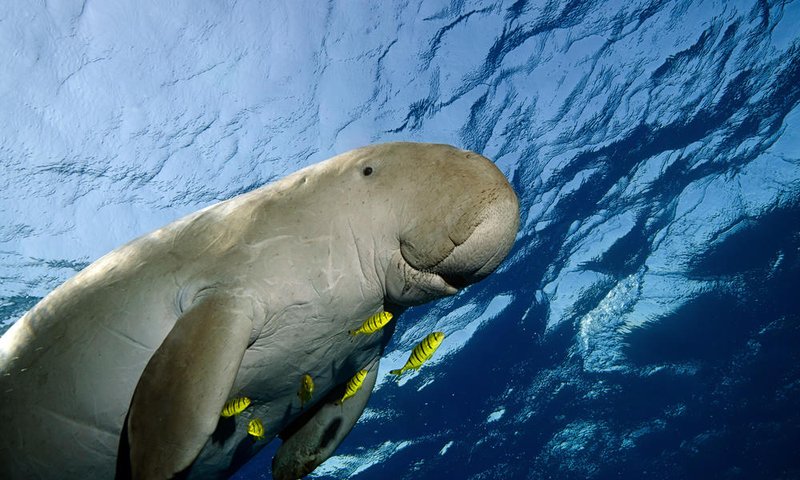
Dugongs are often found in warm waters, especially around seagrass beds. These habitats are crucial for their survival as they feed mainly on seagrass. Given that they are relatively shy and slow-moving, it can be a special moment to come across one. However, it’s essential to know how to interact (or not interact) with these gentle giants. Let’s dive into everything you need to know about encountering a dugong in the wild.
Recognizing a Dugong
Before you can figure out what to do during an encounter, it’s important to know what a dugong looks like. These mammals have a unique appearance that sets them apart from other sea creatures.
Dugongs have a robust, torpedo-shaped body, which can grow up to 10 feet long and weigh around 1,000 pounds. Their skin is usually a grayish or brownish color, often scarred from interactions with boats or other marine life. One of the most notable features of a dugong is its fluked tail, which resembles that of a whale. They also have a distinctively flat, shovel-like snout, making it easier for them to graze on seagrass.
You might be wondering how they differ from manatees, which are often confused with dugongs. While both belong to the same family, dugongs have a more tapered body and a different tail shape. Understanding these features can help identify our gentle friends in the wild, making your encounter even more special.
What to Do When You Spot a Dugong
Now that you can recognize a dugong, let’s talk about what to do if you actually see one. It’s an exhilarating experience, but your actions matter greatly. First, stay calm. Dugongs are curious but can also be easily spooked.
– Observe from a Distance: Keep your distance and watch their behavior. They may be feeding, swimming, or simply resting on the surface. Use binoculars to get a closer look without intruding.
– Avoid Approaching: Never attempt to swim or chase after a dugong. These creatures are protected under various marine conservation laws, and disturbing them can cause them stress.
Remember, they are wild animals, and their safety is a priority. If they seem curious and come closer, that’s a bonus! Just let them explore on their terms.
Safety Tips While Out in the Water
Interacting with marine life comes with responsibility. If you’re out swimming, diving, or kayaking, there are a few safety tips to keep in mind when you encounter a dugong.
1. Keep Your Gear Close: If you’re in a kayak or on a paddleboard, make sure you have all your gear secured. Dugongs can bump into your equipment, so better safe than sorry!
2. Stay Quiet: Loud noises or splashing can frighten dugongs away. Try to stay quiet and calm. This way, you can enjoy the experience longer and help keep them comfortable.
3. Limit Movement: Instead of splashing around, move slowly and deliberately. This allows the dugong to approach at its own pace, which can lead to a more magical encounter.
With these tips, you’re set to enjoy your time in the water while being mindful of these wonderful creatures.
Why Respecting Dugongs Matters
You might be wondering why it’s so important to respect dugongs and their environment. These gentle giants play a critical role in their ecosystems. They help maintain healthy seagrass beds, which support countless marine species.
When dugongs graze on seagrass, they promote its growth, which in turn provides habitats and food for other marine life. Moreover, dugongs are indicators of the health of marine environments. Their presence signifies that the ecosystem is thriving.
By protecting them through respectful interactions, you’re not just preserving a species; you’re contributing to the health of our planet.
Know the Local Regulations
Many regions have specific laws regarding dugong encounters. Understanding these regulations is crucial when you’re out exploring.
– Check Local Guidelines: Before heading out, do some research on the local laws regarding dugong interactions. Some areas might have designated protected zones where swimming near these animals is restricted.
– Follow Guidelines from Tour Operators: If you’re on a guided tour, pay attention to the rules provided by your guides. They are trained in safe and respectful encounters with marine wildlife.
Respecting these guidelines not only keeps you and the dugongs safe but also ensures future generations can enjoy these magnificent creatures.
Help Spread Awareness
After you’ve had a chance to encounter a dugong, consider how you can contribute to their conservation. By sharing your experience with friends, family, or social media, you can help raise awareness about the importance of protecting these animals.
– Educate Others: Discuss the role dugongs play in the ecosystem, and encourage others to be mindful during their own encounters.
– Get Involved: Look into local conservation efforts that focus on marine life, especially dugongs. Many organizations welcome volunteers and donations to support their causes.
Every voice counts when it comes to conservation. By spreading the word, you can inspire others to engage in responsible wildlife interactions.
Closing Thoughts
Encountering a dugong in the wild can be a truly unforgettable experience. By respecting their space, following safety tips, and understanding their importance in our ecosystem, you’re not just a witness to a beautiful moment—you’re also a protector of these incredible creatures. Next time you’re out near the water and get that tingle of excitement, remember the dugong and what it represents. You’ve got the power to make every encounter meaningful, so dive in, enjoy responsibly, and cherish every moment with nature.

